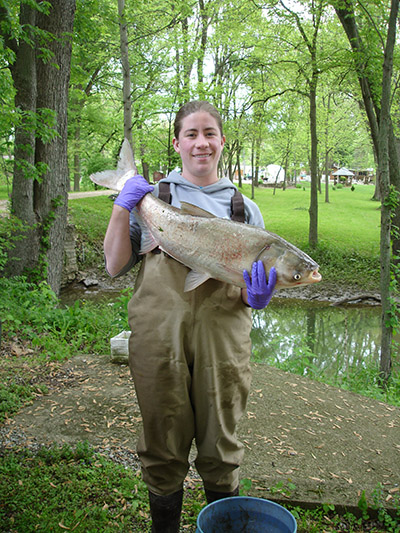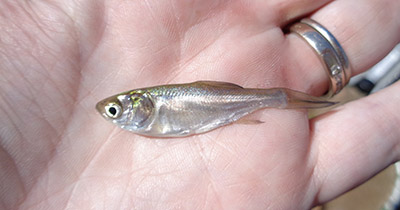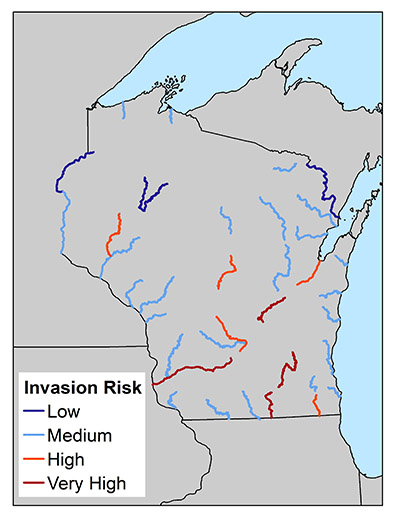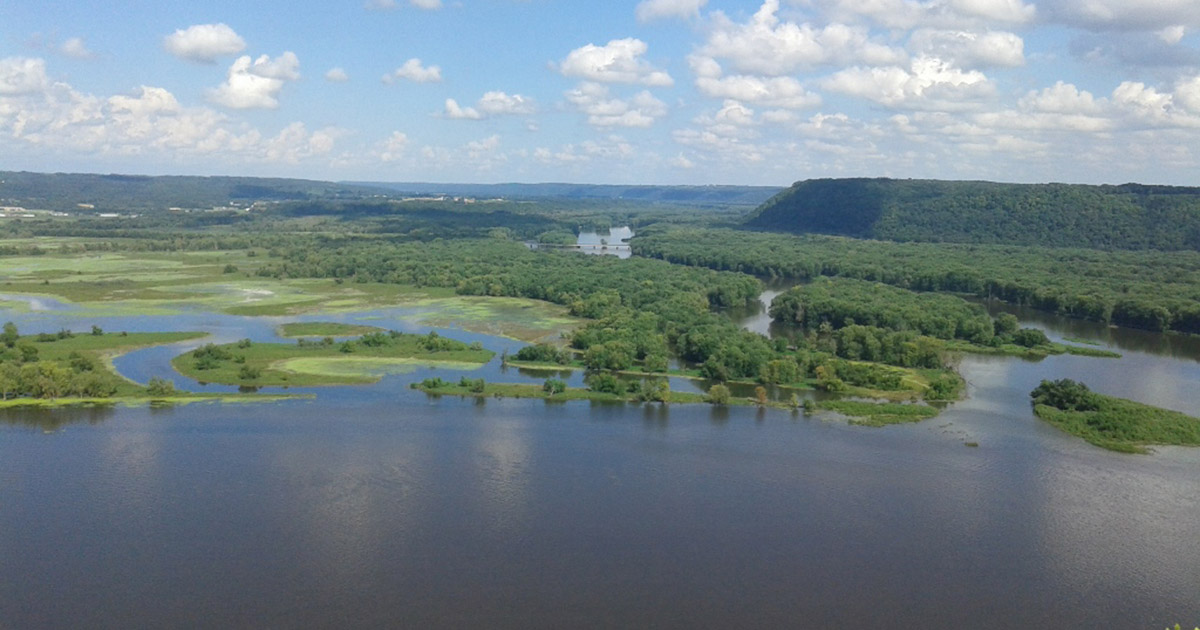Alumni Trio Creates Model to Help Prevent Spread of Invasive Carp
Imagine if something resembling a video game could help eliminate or reduce the spread of invasive species by assessing where the species would best thrive and survive. Thanks to research and an individual based model developed by a trio of Purdue Forestry and Natural Resources alumni, the possibility is not far from reality in relation to invasive carp in Wisconsin rivers and beyond and potentially many other species in the future.
Drs. David and Alison Coulter and Dr. Zach Feiner, who were PhD students at Purdue under Dr. Reuben Goforth, Dr. Tomas Höök and Dr. Marisol Sepúlveda, all graduating in 2015, along with Matt Diebel of the United States Geological Survey have presented their work in the article “Using Individual-Based Models to Develop Invasive Species Risk Assessments by Predicting Species Habitat Suitability” in the Journal of Applied Ecology.
“Alison and I were working to stop carp from spreading from where they already were in the Mississippi, Ohio and Missouri river basins with targeted management or removal, and trying to think of how to combine our expertise with Zach, who was on the front of areas not yet invaded,” explained David Coulter. “We didn’t have direct funding to go out and sample anything, but we wanted to do something that would still be impactful for how decisions are made to prevent carp from becoming a problem. We all chipped in and built a document about what a potential model could look like, developed it into computer code, got environmental conditions and climate change data from Matt and Zach, and collaborated to write the paper, which we thought would be useful for the Wisconsin Department of Natural Resources and also people doing this type of work elsewhere.”
The Players/Developers
At Purdue, David Coulter studied the ecological consequences of environmental change, especially in aquatic systems when humans are causing the change of disturbance to the ecosystem. This work included a look at rivers or lakes, and how humans alter the environment and fish and other organisms respond to that change. Coulter and Zach Feiner also collaborated on a project looking at how warming winters might influence reproduction and eggs in fish. He then completed a postdoc at Southern Illinois University, focusing on conservation and species movement. He is now an associate research scientist at Southern Illinois University.
Alison Coulter brought a knowledge and background working with invasive carp, having completed her PhD dissertation under Goforth on invasive carp in the Wabash River, including how they spread and moved through the system, the ecological impacts they made as a species, and characteristics of the invasive population, including reproduction. She continued working with invasive carp as a postdoctoral researcher at Southern Illinois University under Dr. Jim Garvey, where she used information about the movement of the species to identify locations that were sources of the fish, which could then be targeted for removal. Alison has spent the last two years as an assistant professor at South Dakota State University, where she teaches and does research on fish ecology.
Zach Feiner, an assistant scientist and Wisconsin DNR research liaison for the University of Wisconsin Center for Limnology, worked with the rapid adaptation and evolution of fish in response to climate change and fisheries harvests as a PhD student under Höök. He researched yellow perch and walleye in the Great Lakes region to try to understand how their growth, maturity and egg survival was influenced by things like fisheries harvests and climate change, and how the species might adapt to future change and future stressors. Feiner completed a postdoc at Purdue with Höök and Dr. Rob Swihart looking at food web complexity, or what fish eat, and how important it is for their interactions in various ecosystems. He then accepted a position as a fisheries research scientist with the Wisconsin DNR before transitioning into a hybrid DNR/University role at the Center for Limnology.
Matt Diebel, a hydrologist now with the United States Geological Survey, helped the trio with stream and river temperature and flow predictions, both current conditions and future conditions, which fed into the habitat quality produced in Coulter’s model.
The Game
This research project focused on invasive carp, previously known as Asian carp, a group which is broadly made up of bighead carp (Hypophthalmichthys nobilis), silver carp (H. molitrix), grass carp and black carp. Because grass carp and black carp eat different food items than bighead carp and silver carp, they were not utilized in this model.
broadly made up of bighead carp (Hypophthalmichthys nobilis), silver carp (H. molitrix), grass carp and black carp. Because grass carp and black carp eat different food items than bighead carp and silver carp, they were not utilized in this model.
“Invasive carp can cause a whole suite of problems,” Alison Coulter explained. “The obvious one is boaters being hit and the reduction of people’s general enjoyment of recreating when massive groups of fish are jumping from the water. They can cause injuries, but it is also disruptive and not very aesthetically pleasing. One of the main ecological impacts has been changes in zooplankton and phytoplankton species composition and abundance. Invasive carp are essentially changing the base of the aquatic food web in the rivers they have invaded and then they are directly competing with some native species, including some valuable forage species like gizzard shad. There are also data coming out that show you can link some of these high populations of invasive carp with declines in native sport fish as well.”
This research utilized an individual based model (IBM), which allows each organism to have its own traits and interact uniquely with and within the environment. In an individual based model, each fish is its own character with specific traits and behaviors: fat ones vs. skinny ones, old ones vs. young ones, etc. Equations within the model tell the fish what the environmental conditions are and then based on their individual characteristics they react to those different scenarios accordingly.
“It’s kind of like a video game, where it tracks individual organisms, in our case, fish, and they all have their own traits, from their size and how old they are, to how much they weigh and where they live in the environment, etc.,” David Coulter said. “The IBM allows them all to be unique. For instance, a big fish versus a small fish or even two fish that are the same size but one is very fat and one is very skinny – each is going to respond to the same conditions, such as water temperature, water flow rate or food availability, very differently. A different method of modeling doesn’t track individuals, instead you say they are basically this average size and all respond kind of the same way based on these rules. You lose a lot of the reality that happens in the environment. Individual based modeling tries to recreate what is actually happening in the real world where those animals respond differently.”
Key in the model’s success was the knowledge of invasive carp that Alison brought to the table.
“With these models you have all of these different equations predicting things,” Feiner said. “One of the outcomes that we can look at is how big do the fish have to be to survive in this particular river. One really cool aspect that played off of Alison’s previous work was spawn timing. Because of papers from Alison’s PhD work, Dave was able to essentially hatch juvenile carp on multiple days in a row in the spring and we could see on which days the carp actually survived and figure out how long the possible spawning season was. The spawning is just one example of how individual tracking allowed us to get much more fine-tuned ideas of how important variation or different traits are to the survival and establishment of these fish.”
PhD work, Dave was able to essentially hatch juvenile carp on multiple days in a row in the spring and we could see on which days the carp actually survived and figure out how long the possible spawning season was. The spawning is just one example of how individual tracking allowed us to get much more fine-tuned ideas of how important variation or different traits are to the survival and establishment of these fish.”
The reality of those responses is key when trying to predict behavior such as the spread and survival of invasives in a new environment.
“In this case, we didn’t just want to see where an adult invasive carp could be and whether it could survive in this one river in Illinois or Wisconsin,” Dave Coulter said. “Adults could swim up the river and invade, but at the same time, someone could accidentally introduce a tiny invasive carp in a bait bucket and release live bait and those small fish would then be introduced to the ecosystem. We needed to be able to not only understand how the big ones would survive, but a whole suite of sizes, in various conditions. We thought if we could understand which areas had conditions suitable for these animals to survive, we could tell the agencies, such as the DNR, which areas are most at risk so they could focus their sampling efforts and their monitoring to the most prioritized areas. In addition, we also predicted how the suitability of sites might change with climate change to see whether additional rivers might become suitable for the fish as conditions start to change.”
The applications for the model not only apply to invasive carp in Wisconsin, but across the species potential range, Feiner explained.
“One of the reasons we are interested in Wisconsin is that this is the very front edge of the invasive front,” Feiner said. “By doing individual tracking we were able to get more fine-tuned ideas about how important variation or different traits are to the survival and establishment of these fish. This research does a really good job of highlighting the areas we need to focus on in terms of prevention, and allows us to be more proactive in where and how often we need to monitor certain areas for invasion. The other thing that’s nice about this is the individual based approach, which tells us what sizes of fish to look for. If we’re looking at rivers where only the biggest adults are expected to be able to survive, the way we sample those fish is very different from how we would sample for juvenile fish. In the end, this helps us prioritize where we want to or need to do more monitoring and preventative management to keep the impacts of these carp minimal.”
good job of highlighting the areas we need to focus on in terms of prevention, and allows us to be more proactive in where and how often we need to monitor certain areas for invasion. The other thing that’s nice about this is the individual based approach, which tells us what sizes of fish to look for. If we’re looking at rivers where only the biggest adults are expected to be able to survive, the way we sample those fish is very different from how we would sample for juvenile fish. In the end, this helps us prioritize where we want to or need to do more monitoring and preventative management to keep the impacts of these carp minimal.”
The Outcome/End Game
 The individual based model found that all 38 rivers tested were able to sustain at least one adult animal to survive, but it was able to red flag ones with conditions where individuals of all sizes and ages could survive for longer periods of time, both currently and with climate change adjustments.
The individual based model found that all 38 rivers tested were able to sustain at least one adult animal to survive, but it was able to red flag ones with conditions where individuals of all sizes and ages could survive for longer periods of time, both currently and with climate change adjustments.
As the publication states:
All rivers supported adult survival, although complete survival of all adult demographics and positive growth only occurred in approximately 45% (17 of 38) of rivers for silver carp and 26% (10 of 38) of rivers for bighead carp. Only the largest individuals at the time of introduction survived in rivers where adult mortality occurred. Most rivers were unsuitable for young- of- year (89% and 92% of rivers for silver carp and bighead carp respectively).
Climate change simulations had relatively little effect on adult habitat suitability but resulted in up to four times the number of rivers being suitable for young- of- year by the late- 21st century and greatly extended the viable spawning season by up to an additional 65 days for silver carp and 77 days for bighead carp.
Four of 38 river reaches were classified as currently having very high overall invasion risk which we suggest have management goals and actions that address population control and prevention of all life stages from being introduced if these systems become invaded. Five reaches had high overall invasion risk where limiting immigration or introductions via movement deterrents and bait restrictions are recommended. Most sites (25 of 38) had medium overall risk, where preventing adult immigration is recommended through inhibiting movement from invaded systems.
“An area may have a combination of too little food available and too fast of a water flow or too warm of water, which forces fish to spend a lot of energy swimming and not grow well or to slowly die because they starved,” David Coulter stated. “In other areas, like the center part of the state, there are a couple rivers that were really the red flag area and that is because all sizes, even the smallest fish that we looked at, were able to survive and grow really well. That matched the growth that we see in southern states where the fish are already present. What’s happening there is that you have the sweet spot of water temperature, food availability and the velocity or flow of the water, the speed where the amount of energy the fish have to use to swim is not excessive. They are able to capitalize on the perfect combination of habitat conditions.”
What’s Next
Other agencies and wildlife managers have already expressed an interest in utilizing the model to track and predict invasive carp in their regions.
“With invasive species, it is all about preventing them from occurring, and, if they do occur, being able to detect that they are there at a really low number so that you can take action quickly,” Alison Coulter said. “That’s what a lot of the implications in this paper are: what size you should be looking for when you are monitoring, what gears you might want to use and what locations you might want to be targeting.”
 While Feiner and his colleagues with the Wisconsin DNR and the U.S. Fish and Wildlife Service make applications locally, the research will soon be expanded to apply to a different region.
While Feiner and his colleagues with the Wisconsin DNR and the U.S. Fish and Wildlife Service make applications locally, the research will soon be expanded to apply to a different region.
In January, David Coulter has a student who has received funding to begin working to take the individual based model and apply it to the Missouri River Basin, and tributaries of the Missouri River, where the carp are not yet present.
“This model is very adaptable,” Coulter explained. “If you have the same goals, the same question that we are trying to answer with the model as it currently is, you should be able to take whatever environmental conditions are present at a new location, plug it in and it will give you the same outputs that we present in the case study for Wisconsin. It is not only broadly applicable to other locations, but I would also argue that it is very easy to adapt this model for conservation efforts for different species. So, if you’re not necessarily concerned about silver carp or big head carp in a given location, but instead are worried about a different fish species invading your area, you could take the model and apply to a different species with very little modification.
“For the Missouri River Basin project, my student just needs to get environmental conditions – either from agencies that already have the data and will share it with us, or go out and collect the data himself – and then tweak the model a little bit. But, more of less, he should be able to just plug it in directly and get results from that.”
The model has not yet been made available for public use, but the research group has not ruled that out for the future once it has been expanded from the state of Wisconsin to a broader region and tested and adapted if necessary. Those interested in utilizing the model should contact Dave Coulter at David.Coulter@sdstate.edu.






